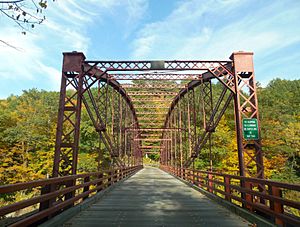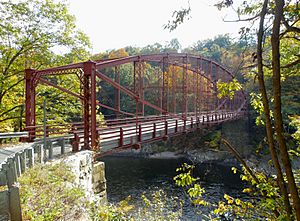Bardwell's Ferry Bridge facts for kids
Quick facts for kids Bardwell's Ferry Bridge |
|
|---|---|

Historic Bardwell's Ferry Bridge over the Deerfield River
|
|
| Coordinates | 42°33′20″N 72°40′41″W / 42.55556°N 72.67806°W |
| Carries | Bardwell's Ferry Road |
| Crosses | Deerfield River |
| Locale | Conway, Massachusetts |
| Characteristics | |
| Design | Truss bridge |
| Total length | 198 ft (60 m) |
| Width | 14 ft (4.3 m) |
| History | |
| Designer | Douglas, William O.; Berlin Iron Bridge Co. |
| Construction end | 1880 |
|
Bardwell's Ferry Bridge
|
|
| Nearest city | Conway, Massachusetts |
| Built | 1882 |
| Architect | William O. Douglas, Berlin Iron Bridge Co. |
| NRHP reference No. | 00000076 |
| Added to NRHP | February 10, 2000 |
The Bardwell's Ferry Bridge is a very old and special bridge. It was built in 1882. This historic bridge crosses the Deerfield River in Massachusetts. It connects the towns of Shelburne and Conway. The bridge is famous for its unique "lenticular truss" design. It is also listed on the National Register of Historic Places. This means it is an important historical landmark.
Contents
About the Bardwell's Ferry Bridge
The Bardwell's Ferry Bridge carries Bardwell's Ferry Road. It crosses the Deerfield River below. The bridge is in a deep valley. The roads leading to it are quite steep.
What Makes It Special?
This bridge was built by the Berlin Iron Bridge Co.. This company was from East Berlin, Connecticut. The Bardwell's Ferry Bridge is about 198 feet (60 m) long. It is the longest single "lenticular truss" bridge in Massachusetts.
A "lenticular truss" bridge has a special shape. Its top and bottom parts curve outwards. This makes it look like a lens or an eye.
A Unique Shape: "Pumpkin-Seed" Bridges
The Berlin Iron Bridge Co. built many bridges like this. They made almost 800 of them in the late 1800s. Most were in New England. Some were built as far away as Ohio and Texas.
These bridges are often called "pumpkin-seed bridges." They are also known as "cats-eyes bridges." Other names include "elliptical truss bridges" or "parabolic truss bridges." All these names come from their unique lens-like shape. Lenticular bridges were mostly used for cars and wagons. They were not strong enough for heavy trains or trolleys.
Bridge Details and History
The bridge deck is 14 feet (4.3 m) wide. It is made of wooden planks. The Bardwell's Ferry Bridge was carefully fixed up in the 1990s. This helped keep it strong and safe.
In 2000, the bridge was added to the National Register of Historic Places. This honor recognizes its importance. It is a great example of old bridge building.



